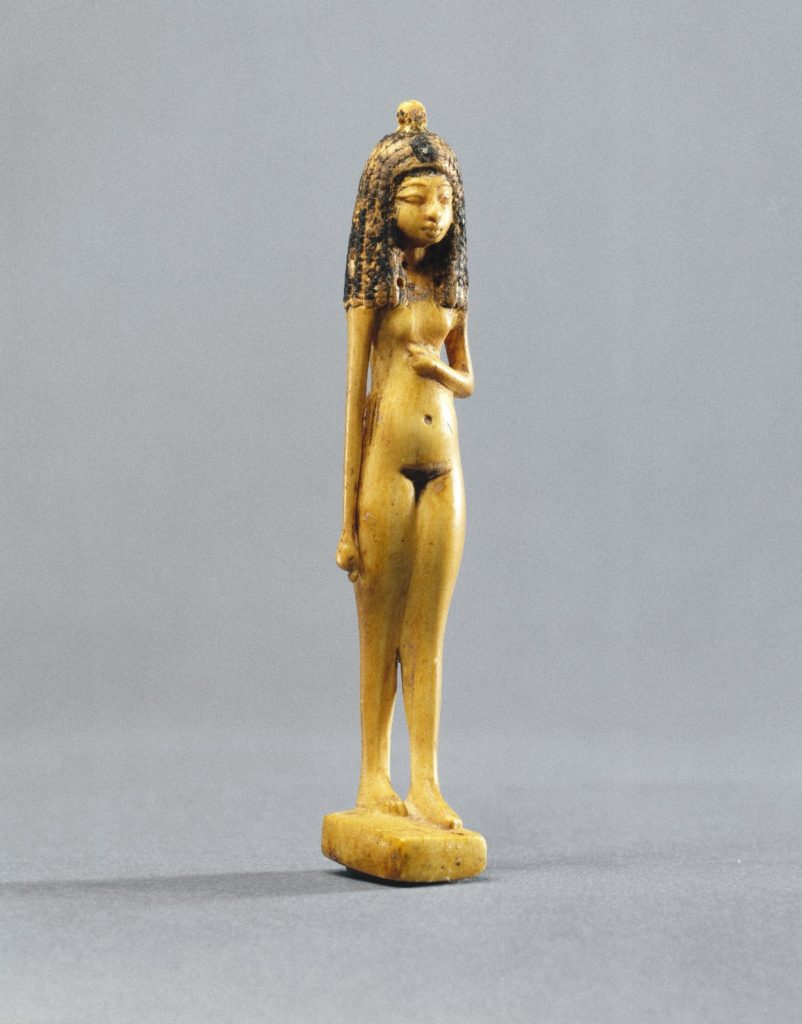
Statuette of a Nude Girl, ca. 1390-1353 B.C.E. Ivory, painted, 3 1/4 x 5/8 in. (8.3 x 1.6 cm). Brooklyn Museum, Charles Edwin Wilbour Fund, 40.126.2.
Despite being over 3 inches long, this nearly perfect figurine might have been worn as a necklace by someone. But who, and why?
Ancient Egyptians often wore intricate hairstyles or heavy wigs. Though many Egyptians shaved their heads to stay cool, being bald was considered unattractive, so men and women of all classes (except priests and some labourers) wore wigs. Elaborate wigs and hairstyles were even worn during sex. As such, this figurine with its heavy wig may well have been erotic in nature. The small loop on the top of the statuette implies that it was hung, though from a necklace or as a decoration for a room is unknown.
The statuette was made during the 18th Dynasty (c. 1543 to 1292 BCE), when Egypt was at its most prosperous. The 18th Dynasty includes some of the best known Pharaohs, including Hatshepsut, Akhenaten, and Tutankhamun. The piece is dated to 1390-1353 B.C.E., so it was made during the reign of Thutmose IV or Amenhotep III. Stylistically, this makes sense. Amarna Period art (from the reign of Akhenaten) has a very distinct and different style from the art both before and after it. Amarna Period sculptures feature elongated heads, prominent chins, and much larger stomachs, thighs, and hips than any other period of Ancient Egyptian art. In contrast, the figurine above is slender and only gently curved, with facial features in the traditional style.
So what was this piece used for? Was it a necklace? Though possible, as amulets were worn (usually for protective purposes), much of the jewelry in Ancient Egypt tended to favor beadwork and bands, such as the jewelry of the Child Myt. These pieces, made of gold, carnelian, glass, and other materials strung onto linen, are much more common body decorations than the figurine. Though we may never know its specific use, it does give show what the “ideal” standard of beauty was in Ancient Egypt.
-Katie Weidmann
Social Media Manager
Girl Museum, Inc.
This post is part of our 52 Objects in the History of Girlhood exhibition. Each week during 2017, we explore a historical object and its relation to girls history. Stay tuned to discover the incredible history of girls, and be sure to visit the complete exhibition to discover the integral role girls have played since the dawn of time.
For more on Ancient Egyptian Art, check out Gay Robin’s books, including Women in Ancient Egypt (British Museum Press and Harvard University Press, 1993), Proportion and Style in Ancient Egyptian Art (University of Texas Press, 1994), and The Art of Ancient Egypt (British Museum Press and Harvard University Press, 1997).
